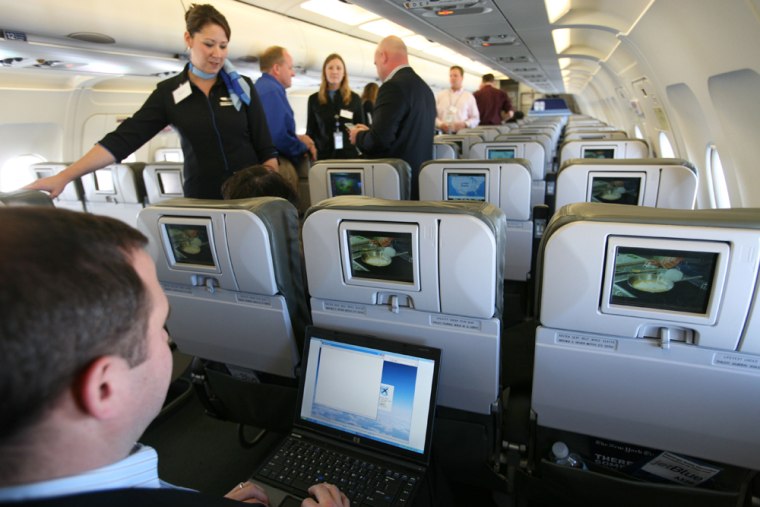Surfing the Web at 500 miles per hour and 35,000 feet. What a concept.
Actually, it’s about to become reality. After years of false starts, countless press releases and enough breathless blog posts to crash a server farm, the age of commercial in-flight Internet access has arrived. It’s only been offered on one plane from one airline so far, but you can bet your network card it’s about to go viral.
The plane in question is an American Airlines 767-200 which was configured to provide free broadband Internet access on two flights between New York and Los Angeles last Wednesday. Considered a “dress rehearsal” for a larger rollout later this month, the flights could also be considered the first salvo in what will be a battle for the hearts, minds and mouse devices of the flying public.
Here’s where things stand as of now:
American Airlines
Based on the results of last week’s flights, American expects to begin offering broadband Internet access on its 15 767-200s sometime this month. It will be available on flights between New York (JFK) and California (Los Angeles and San Francisco) and on one flight per day between JFK and Miami.
Called Gogo Inflight Internet, the service will cost $12.95 per flight on flights of three hours or more (and $9.95 on flights of less than three hours when available). Because it operates via a ground-based network of 92 cell towers developed by broadband provider Aircell LLC, the system will only work over the contiguous U.S.
Virgin America
The San Francisco-based airline, which is also planning to use Aircell’s Gogo system, is currently conducting lab tests on a mock-up aircraft. They expect to begin in-flight testing this year with a commercial rollout in early 2009. Pricing has not been announced.
According to Charles Ogilvie, director of in-flight entertainment and partnerships, the goal is to create “a social network in flight” by offering the service fleetwide and integrating it with Red, the airline’s seatback entertainment system. “You’ll even be able to play video games against people on other flights,” says Ogilvie.
JetBlue
JetBlue got the in-flight connectivity ball rolling last December when it unveiled BetaBlue, a Wi-Fi-equipped A320 that offered passengers free access to e-mail and/or chat services via Yahoo! and select BlackBerry devices. Last month, the company added support for more platforms, including Gmail, Hotmail, AOL Mail and Windows Live Mail, along with access to Amazon Mobile and Microsoft Exchange-based corporate e-mail accounts.
Southwest Airlines
The airline expects to begin in-flight testing on four planes later this summer via a satellite-based system developed by Row 44 Inc., which means it will work over water. “Depending on how the tests go, it could be activated as early as this fall,” says spokesperson Ashley Rogers.
Alaska Airlines
Alaska is also working toward providing satellite-based broadband via Row 44. The company expects to begin in-air testing on one plane starting in August with potential implementation in the fall. Pricing and fleetwide implementation haven’t been determined.
Clearly, the demand is there. According to a study by Forrester Research, 55 percent of leisure travelers expressed an interest in getting online on flights of four hours or more. (The percentage drops to 41 percent on flights of two to four hours and 24 percent on flights of one to two hours.) “The number of e-mails I get per day asking when we’ll turn it on is unbelievable,” says Ogilvie.
“It’s the No. 1 demanded in-flight service,” echoes Doug Backelin, manager of in-flight communications and technology at American. “It’s not just surfing the Web. It’s communication, it’s movies, it’s a way to keep kids from kicking the back of the seat in front of them.”
Of course, like any new idea, it also raises new questions:
What about, ahem, inappropriate content?
The airlines are not planning to block objectionable Web sites. Instead, they’ll rely on passenger discretion and existing policies that cover magazines, DVDs and other prurient personal items.
Will you be able to make Internet-routed (VoIP) calls?
Thankfully, no. The systems can be configured to enable or disable voice-based functions, and the airlines are opting to prohibit them — at least for now.
Is it worth it?
That, I suppose, depends on how connected you want or need to be. Personally, I already spend enough time staring at a computer screen and don’t mind being out-of-pocket when I fly. On the other hand, as the airlines cut out everything from meals to magazines to in-flight movies, what else is there to do as the hours crawl by?
Me? I’ll probably do what I usually do when I get on a plane. I’ll open a book or a magazine, read a page or two and proceed to pass out for the duration of the flight. In-flight Internet access may be poised to take off, but I’m guessing I’ll have plenty of company.
